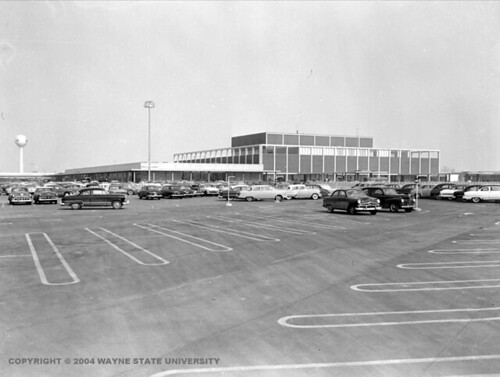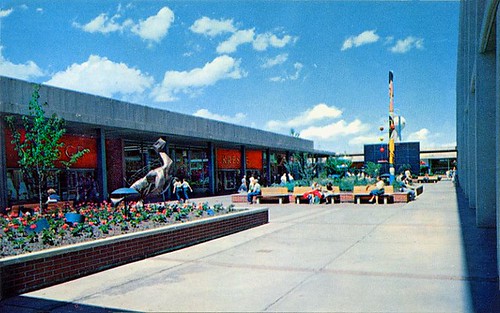Another indication of the decline of Detroit and "the mall" and inner suburbs: the decline of the Northland Shopping Center/Macy's to close

Northland Center (above) was the first post-WWII shopping center built in the Detroit Metropolitan area, in Southfield Michigan, and one of the earliest suburban shopping centers in the US. (Note that the Hecht Company's Parkington Center opened in Arlington County, Virginia three years earlier.)
It was built by JL Hudson Company, the city's pre-eminent department store company, and was the first of a bevy of shopping centers ringing the center city including Eastland, Westland, and Southland.
Note that especially in the Chicago region, in the 1920s and 1930s it was not uncommon for department stores to open branch stores, not shopping centers, outside of the big downtown stores, but that practice was atypical elsewhere in the country. Mostly, residents went to the Downtown in the center city to shop. (In the DC region, what is now called Ballston in Arlington County, was the first suburban shopping center built by the local chain, Hecht's, after they opened their first branch store in Silver Spring, which stayed open until the 1980s.)
Northland aimed to serve suburban residents by bringing Downtown to them.
The complex was designed by Victor Gruen, a German-American architect famed at the time for retail store design, who then went on to design many shopping centers across the country, along with city master planning ("The Terrazzo Jungle," New Yorker Magazine) and even some work for Disney.
Northland was open-air, with a four-story Hudson's at the center. But after the creation of a fully enclosed Southdale Center in Greater Minneapolis a couple years later by the Dayton Company, which was associated with Hudsons and later the companies merged, after Northland, later Hudson's-built shopping centers were built from the outset as enclosed spaces and Northland was eventually converted. (I do have memories of the center in its open-air days.)
Hudson's, merged along with Daytons into Chicago-based Marshall Field's by 2001, was one of the many regional department stores that became part of Macy's over the course of the 2000s.
Macy's is the nation's largest department store chain, which was created through the amalgamation of a large number of regional department store chains. Eventually all of the regionally significant store names (Hecht's, Filenes, Jordan Marsh, Rich's, Broadway, etc.) were dropped in favor of the Macy's name, and the company repositioned as an integrated national company rather than regional brand.

Thursday, Macy's announced that this year, it will be closing 14 stores (and opening 3 new stores). One of those stores to be closed is at Northland Center, ironically, one of the first suburban department stores ever built.
-- "Officials Say Mall Key To Economic Future In Southfield," WDET-FM
Apparently, the other anchor store at the mall, a Target, will be closing next month, leaving the center with no anchors.
Northland, in Southfield, immediately north of Detroit, along 8 Mile Road in Oakland County, was a harbinger of doom for Detroit as a center city. The construction of the center and the opening of the Hudson's store was the leading sign of population outmigration from center cities and the rise of the suburbs more generally, it is ironic that this particular mall is losing its foremost anchor ("How a mall set the tone for Detroit's decline," letter to the editor, Detroit Free Press).
That being said, Oakland County is still one of the nation's wealthiest counties as discussed in this entry ("The rise of Oakland County is built upon Detroit's fall").
But we must be judicious with the Northland Center story, as it's easy to overgeneralize from the experience of Detroit and its inner ring suburbs, although few cities in the US have fallen quite as far as Detroit. Part of the story is demographic change, as Southfield changed from a Jewish-majority city to an African-American majority city, in an otherwise very white conservative Oakland County.
And Northland has other issues arising from its design (see shopping directory sign at left).
The center was built originally by Hudson's to highlight Hudson's as the sole anchor department store, so the shopping center was built with Hudson's at the center, with smaller stores surrounding it, making it difficult to fit other anchors onto the site.
Later designs for shopping centers put department stores at the outer edges, with a department store at the end of each wing.
Such design issues were typical of shopping centers built by department store companies, as these firms were unaccustomed to having to share store space with others ("The Mixed Blessings of Success: The Hecht Company and Department Store Branch Development after World War II," by GWU professor Richard Longstreth). Eventually, independent developers became the primary force for developing the shopping mall, and sharing customers with other department stores in the mall became common practice.
Also see "Turnabout is fair play: why Topher Matthews/GGW is wrong about TIF incentives for a department store in Georgetown..." from 2012, which discusses incentive practices as they relate to department stores (and supermarkets) as retail anchors.
Labels: commercial district revitalization, department stores, suburban revitalization






0 Comments:
Post a Comment
<< Home